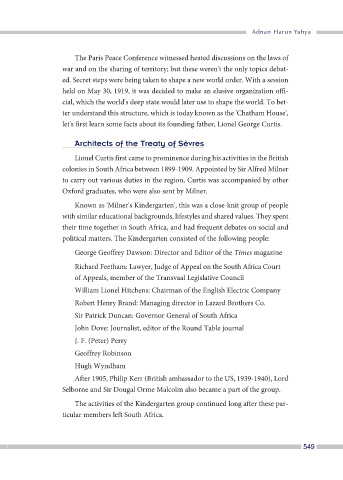Page 551 - Mastermind: The Truth of the British Deep State Revealed
P. 551
Adnan Harun Yahya
The Paris Peace Conference witnessed heated discussions on the laws of
war and on the sharing of territory; but these weren't the only topics debat-
ed. Secret steps were being taken to shape a new world order. With a session
held on May 30, 1919, it was decided to make an elusive organization offi-
cial, which the world's deep state would later use to shape the world. To bet-
ter understand this structure, which is today known as the 'Chatham House',
let's first learn some facts about its founding father, Lionel George Curtis.
Architects of the Treaty of Sèvres
Lionel Curtis first came to prominence during his activities in the British
colonies in South Africa between 1899-1909. Appointed by Sir Alfred Milner
to carry out various duties in the region, Curtis was accompanied by other
Oxford graduates, who were also sent by Milner.
Known as 'Milner's Kindergarten', this was a close-knit group of people
with similar educational backgrounds, lifestyles and shared values. They spent
their time together in South Africa, and had frequent debates on social and
political matters. The Kindergarten consisted of the following people:
George Geoffrey Dawson: Director and Editor of the Times magazine
Richard Feetham: Lawyer, Judge of Appeal on the South Africa Court
of Appeals, member of the Transvaal Legislative Council
William Lionel Hitchens: Chairman of the English Electric Company
Robert Henry Brand: Managing director in Lazard Brothers Co.
Sir Patrick Duncan: Governor General of South Africa
John Dove: Journalist, editor of the Round Table journal
J. F. (Peter) Perry
Geoffrey Robinson
Hugh Wyndham
After 1905, Philip Kerr (British ambassador to the US, 1939-1940), Lord
Selborne and Sir Dougal Orme Malcolm also became a part of the group.
The activities of the Kindergarten group continued long after these par-
ticular members left South Africa.

